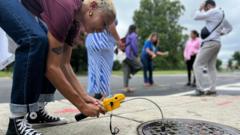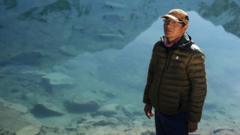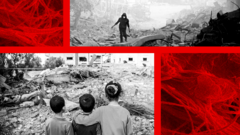Volunteers and researchers are investigating methane emissions in Washington DC, using advanced hand-held and satellite technologies. As methane proves difficult to detect yet significantly impacts human health and climate change, ongoing efforts aim to enhance monitoring and reporting strategies to mitigate its effects.
Uncovering Methane: A Critical Challenge in Environmental Monitoring

Uncovering Methane: A Critical Challenge in Environmental Monitoring
The detection of methane emissions is essential for public health and climate management. Efforts are being made at community and satellite levels to unveil this hidden danger.
In and around Washington DC, dedicated volunteers and activists have been actively assessing air quality by walking through neighborhoods and homes, armed with sophisticated industry-grade monitors designed to detect various gaseous substances. These devices resemble walkie-talkies but are equipped with advanced sensors that quantify the presence of methane, transforming this invisible gas into tangible data visible on a display.
The findings have raised significant alarm. Over a 25-hour research period, these community researchers identified 13 outdoor methane leaks, with concentrations surpassing the lower explosive threshold. Alarmingly, they also detected leaks inside residences. Methane emissions raise considerable health concerns, particularly for children, as evidenced by alarming statistics from Djamila Bah, a healthcare worker and tenant leader at the community organization Action in Montgomery. She noted that one in three children in the tested homes suffers from asthma, a condition exacerbated by pollutants like methane and nitrogen oxides from common sources such as gas stoves. “It's very heartbreaking and alarming,” Bah says, highlighting the urgency of addressing these hazardous conditions.
Not only is methane a human health threat, but it is also a potent greenhouse gas. Methane’s shorter atmospheric lifespan compared to carbon dioxide (CO2) does not mitigate its impact, as it is capable of trapping heat far more effectively. Consequently, methane is responsible for approximately 25% of the rise in global temperatures since the advent of industrialization. Emissions can arise from various sectors, including fossil fuels, waste management, and agriculture; yet, detecting methane can be problematic.
While handheld sensors have emerged as a practical solution for monitoring, advancements continue in technology, with infrared cameras being utilized to visualize methane emissions. Ground-based monitoring through vehicle-mounted devices, as well as aerial methods like drones, enhances detection capabilities, but challenges persist. “There is no perfect solution,” states Andreea Calcan of the International Methane Emissions Observatory, a UN initiative. The balance between technology cost and comprehensive analysis remains a complex issue.
On a larger scale, satellites are becoming instrumental in identifying significant methane emitters, including extensive oil and gas leaks as well as the smaller-scale emissions from agriculture. However, varying environmental factors can hinder satellite effectiveness. Mr. Riley Duren from Carbon Mapper explains that traditional satellites typically focus on either large or small emitters, much like different camera lenses in photography.
The newly launched Tanager-1 satellite aims to combine high resolution and quick detection, making it capable of pinpointing emissions from super-emitters more accurately. Despite the challenges faced in certain environments, Tanager-1, developed in collaboration with NASA, is designed to overcome many visibility obstacles. Carbon Mapper has begun to provide emissions data from satellite observations, shedding light on methane emissions that previously remained undetected.
Moreover, new initiatives like the MethaneSAT from the Environmental Defense Fund, which also commenced operations in 2024, are similarly focused on improving methane monitoring. As data collection methods refine, “What was previously unseeable is now visible,” Duren asserts, emphasizing society's ongoing learning regarding its methane footprint.
Notably, despite the increase in available information, methane levels continue to rise. The Methane Alert and Response System (MARS) utilizes satellite data to detect and report methane emissions to relevant stakeholders. In its short lifespan, MARS has sent over 1,200 alerts of significant methane leaks, though only a meager 1% received subsequent action. However, optimism remains as direct actions such as repairs have been noted, sometimes without formal communication from operators.
At the community level, initiatives empowering residents to take air quality readings are proving impactful, enabling them to challenge misinformation. Joelle Novey from Interfaith Power and Light encapsulates this sentiment: “Now that we know better, we can do better.” As the world grapples with this critical challenge, improving detection and response to methane emissions stands paramount for public health and climate sustainability.





















